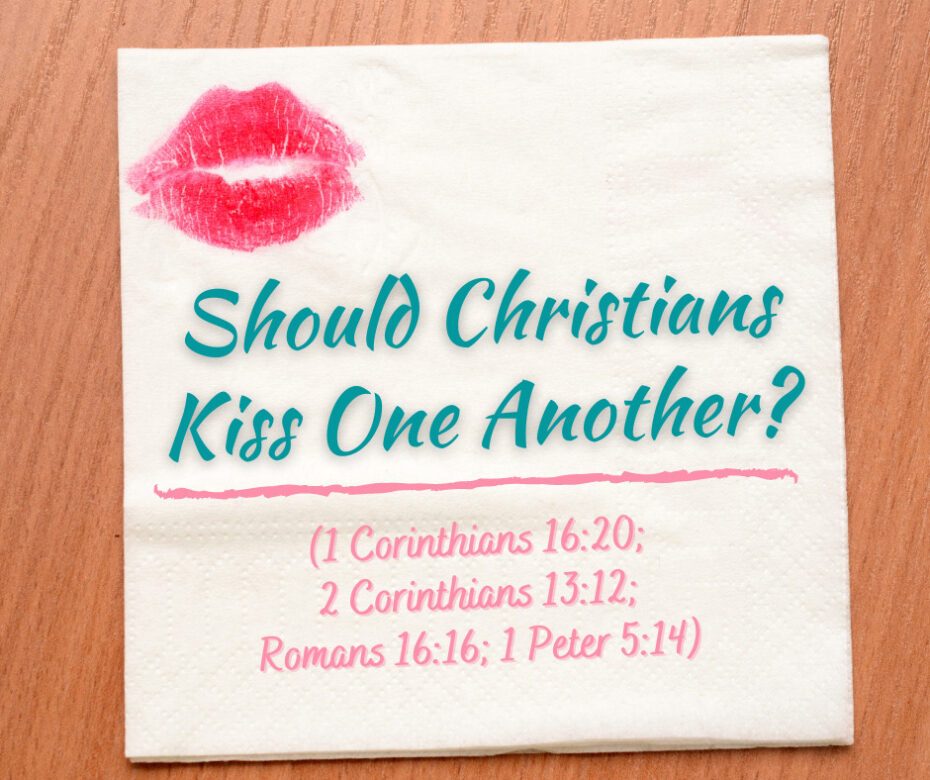I grew up in a French city where it was customary to greet people with a double-cheeked kiss. At least, that was normal among my French relatives. Meanwhile, my British/English circles preferred a firm handshake or nod of the head—or, if they felt especially informal, a quick hug.
I have been studying the many “one another” commands of the NT that together describe a normal church life, and, to my surprise, kissing comes up often:
All the brethren greet you. Greet one another with a holy kiss (1 Cor 16:20).
Greet one another with a holy kiss (2 Cor 13:12).
Greet one another with a holy kiss. The churches of Christ greet you (Rom 16:16).
Greet all the brethren with a holy kiss (1 Thess 5:26).
Greet one another with a kiss of love. Peace to you all who are in Christ Jesus. Amen (1 Pet 5:14).
Do you kiss each other in church?
I’ve only seen it done once—at a conservative Mennonite church. This group wore clothes from the 1800s but drove modern cars and trucks (that had to be painted black). Everyone was very welcoming, and I remember thinking the kids were exceptionally well-behaved during the service.
Then it came time for the “holy kiss.”
I didn’t know what that was but assumed they might give each other a peck on the cheek.
Nope!
To my utter shock, these big ‘ole Mennonite farmers puckered up and started locking lips! Men to men. Lip to lip. “I’m just visiting!” I said as I backed away.
Is that what the apostles required?
Arnold Fruchtenbaum claims this was “a kiss on the cheek or both cheeks” (The Messianic Jewish Epistles, p. 384), but Robert Jewett cites evidence that it was “mouth to mouth” (Jewett, Romans, p. 973).
Meanwhile, William Barclay says: “With the Jews it was the custom for a disciple to kiss his Rabbi on the cheek and to lay his hands upon his shoulder. That is what Judas did to Jesus (Mark 14:44). The kiss was the greeting of welcome and respect, and we can see how much Jesus valued it, for he was grieved when it was not given to him (Luke 7:45)” (Barclay, The Letters of James and Peter, pp. 322-23). Exchanging a kiss was important to Jesus. It also mattered to the early Christians: “In the early Church, the kiss became an essential part of Christian worship,” Barclay explains. By St. Augustine’s time, the kiss was part of celebrating communion. “The kiss was the sign that all injuries were forgotten, all wrongs forgiven, and that those who sat at the Lord’s table were indeed one in the Lord” (Barclay, p. 323).
But as you can imagine, kissing could be abused, and it was soon regulated and ritualized. Priests could only kiss bishops, and laypeople could only kiss members of the same sex. (Meanwhile, Barclay reports that the Eastern church replaced kissing people with kissing icons.)
The bottom line is if you take the “one another” command seriously, kissing ought to be part of normal church life. But how can Christians reinstate that practice?
Jack Cottrell agrees the apostles meant the holy kiss to be “an obligatory part of public worship.” However, he thinks the essence of the kiss, not the cultural form is what is important today. “Its essence is that of fellowship and brotherhood; it is a concrete expression of the familial bond that exists among all Christians.” In other words, in those days, and in that culture, they exchanged kisses to greet one another as family and friends. But in a different culture a different greeting might be more appropriate. “Other cultural expressions of affection, fellowship, and brotherhood will serve the same purpose, e.g., a warm handshake or a hug” (Romans, p. 548).
He could be right. However, could the specific act of kissing be important precisely because it is something you normally reserve for family?
For example, Jewett says in ancient times, hosts kissed guests to mark them as members of the extended family (Jewett, Romans, p. 973). Likewise, when Christians kissed one another, it showed they were “building a new social reality” (Jewett, Romans, p. 973)—in other words, kissing demonstrated that believers were a new family.
In fact, Barclay attributes the loss of the holy kiss to a loss of the sense of the familial nature of Christian community:
To us, the kiss of peace may seem very far away. It came from the day when the Church was a real family and fellowship, when Christians really did know and love one another. It is a tragedy that the modern Church, often with vast congregations who do not know each other and do not even want to know each other, could not use the kiss of peace except as a formality. It was a lovely custom which was bound to cease when the reality of fellowship was lost within the Church (Barclay, p. 325).
If you care about creating a community where the church is considered family, you might want to rethink kissing the holy kiss goodbye.


